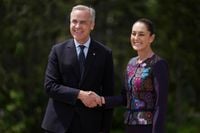Prime Minister Mark Carney’s government has been thrust into the spotlight this August, navigating a turbulent mix of regulatory controversy, environmental backlash, and swirling rumors of scandal. In less than two months since taking office, Carney’s administration has made several high-stakes decisions—each stoking debate over transparency, accountability, and the government’s true priorities in an era marked by economic anxiety, climate crisis, and deepening public skepticism.
Perhaps the most consequential move came last week, when the Carney cabinet endorsed a Canadian Radio-television and Telecommunications Commission (CRTC) policy that allows Vancouver-based Telus to present itself as a “new entrant” in Ontario and Quebec. This status unlocks regulatory privileges designed to foster competition in Canada’s notoriously concentrated telecom sector, where Bell, Rogers, and Telus have long dominated the landscape. According to The Globe and Mail, the decision enables Telus to benefit from rules meant to help upstarts break into the market, a move that has infuriated established players in Ontario, Quebec, and Atlantic Canada.
The backlash was immediate and fierce. Montreal-based BCE (better known as Bell) warned that the policy would force it to slash investment in new infrastructure. Cogeco, a smaller Quebecois company, was even more blunt. “I am in shock,” Cogeco CEO Frédéric Perron told National Post. The Bloc Québécois demanded an immediate reversal, and Toronto’s Rogers, along with Nova Scotia’s Eastlink, joined the chorus of critics. Lee Bragg, vice chair of Eastlink, urged consumers to “reach out to their local MP to voice concerns about this decision and the unintended consequences of losing, not gaining, sustainable competition.”
Yet, for all the uproar, the government’s decision was less about politics than process. Industry Minister Mélanie Joly, herself a Quebec MP, led the charge in supporting the CRTC, even as her own province’s companies protested. This, as The Globe and Mail notes, is remarkable at a time when public trust in democratic institutions is fragile. The Carney government chose to back the independent regulator rather than bow to political pressure, a stance that might prove costly in the short term but signals a commitment to institutional integrity.
Still, the fallout is complicated. Critics argue that the decision favors Telus—already an industry giant—over smaller competitors like Cogeco and Eastlink, who have carved out niches by serving rural and underserved communities. The policy’s intent, dating back to the Harper era, was to nurture competition and break the oligopoly. Granting Telus the same access as smaller players, some say, risks further entrenching the big three’s dominance. As one industry analyst put it, “We doubt that Telus will end up investing much incremental capital, but we are impressed with the opportunistic PR strategy.”
Telus, for its part, announced on July 21 that it would invest an additional $2 billion in Ontario and Quebec over the next five years. Whether that promise will materialize remains to be seen. TD Cowen analysts expressed skepticism, suggesting Telus would be unlikely to spend “anywhere close” to that amount, especially if it meant exceeding capital targets. BCE, they noted, would likely “step up” to defend its territory.
But the debate over telecom policy is only one front in a summer of scrutiny for Carney’s Liberals. On August 12, Carney’s government passed Bill C-5, granting cabinet sweeping powers to bypass environmental reviews and protections. The timing couldn’t have been more fraught: Canada is enduring its second-worst wildfire season in history, with evacuations stretching from coast to coast. The move has drawn sharp criticism from environmental advocates and young Canadians, many of whom remember Carney’s 2015 “tragedy of the horizon” speech urging foresight on climate change.
Martin Musser, writing in a letter to the editor, captured the generational frustration: “Young people deserve more from their government. They deserve to have optimism and confidence in their future. That’s the Canada I want to build.” Musser questioned whether granting the cabinet such powers, especially amid climate disaster, is the “more” that young people deserve—or just another example of sidelining their rights to a climate-safe future. The sense of betrayal was palpable on International Youth Day, when seven young Ontarians launched a lawsuit (Mathur v. Ontario) to hold the government accountable for climate harms. For them, as Musser wrote, “actions speak louder than words.”
As if these controversies weren’t enough, Carney’s government has also been dogged by a fast-spreading rumor about donated blood plasma. In mid-August, social media posts alleged that Canadian Blood Services (CBS) had sold donated plasma to Spanish pharmaceutical giant Grifols, which then resold it for profit. The twist? Grifols was reportedly targeted for takeover by Brookfield Asset Management—a Canadian fund with which Carney has long-standing ties. The rumor, amplified by a viral video with over 300,000 views, claimed this was “one of the biggest scandals of the year.”
The facts, however, are more nuanced. According to Snopes, the original claim stemmed from an investigative report by The Globe and Mail, which said Grifols was “selling medicine abroad” made from blood plasma donated to CBS. CBS responded that plasma collected in Canada is used exclusively for Canadian patients. However, in early 2025, CBS did agree to sell Grifols the byproducts leftover from immunoglobulin manufacturing—material that would otherwise be discarded. Grifols, in turn, could use these byproducts to create albumin for foreign patients, since Canada’s needs for these medicines were already met. CBS explained, “The sale of the byproducts to Grifols offsets the cost Canadian Blood Services pays for immunoglobulins manufactured by Grifols.”
Brookfield Asset Management, meanwhile, had indeed been in takeover talks with Grifols in late 2024 and again in April 2025, though no deal was finalized. Carney’s connection? He owned $6.8 million in unexercised Brookfield stock options as of December 31, 2024, and had served as chair of Brookfield’s board until announcing his Liberal leadership bid. Importantly, before taking office, Carney placed these assets into a blind trust—a standard ethics move that prevents him from influencing or being influenced by the fund’s investments. The ethics commissioner confirmed the inclusion of Brookfield stock options in Carney’s blind trust as of July 10, 2025.
Despite the rumors and political attacks—Conservative MPs have called for a parliamentary investigation—there is no evidence that Carney was involved in, or profited from, the plasma byproduct deal. As Snopes put it, “We did not receive direct confirmation that Grifols was selling specifically albumin made from Canadian plasma abroad, or that Carney had any involvement with this matter.”
In the end, Carney’s early days as prime minister have been anything but quiet. From regulatory shakeups in telecommunications to environmental flashpoints and viral scandal rumors, his government is being tested on multiple fronts. The coming months will reveal whether these controversies mark growing pains or the start of deeper challenges for Canada’s newest leader.





